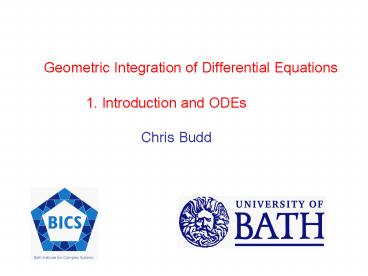Geometric Integration of Differential Equations - PowerPoint PPT Presentation
1 / 31
Title:
Geometric Integration of Differential Equations
Description:
Want to simulate a physical system governed by differential equations ... All Gauss-Legendre Runge-Kutta methods and associated collocation methods are symplectic ... – PowerPoint PPT presentation
Number of Views:106
Avg rating:3.0/5.0
Title: Geometric Integration of Differential Equations
1
Geometric Integration of Differential
Equations 1. Introduction and ODEs Chris
Budd
2
Want to simulate a physical system governed by
differential equations
Expect the numerical approximation to have the
same qualitative features as the underlying
solution
3
- Traditional approach
- Carefully approximate the differential operators
in the system - Solve the resulting difference equations
- Monitor and control the local error
Basis of most black box codes and gives excellent
results over moderate computing times BUT This
is a local process and does not pay attention to
the qualitative (global) features of the solution
Geometric Integration
Aims to reproduce qualitative and global features
4
Some qualitative properties
Conservation laws Global quantities Energy,
momentum, angular momentum Flow invariants
Potential vorticity, Casimir functions Phase
space geometry Symplectic structure Symmetri
es Galilean Reversal Scaling
Nonlinear Schrodinger Lie Group SO3 (Rigid
body) Asymptotic behaviour Orderings
Some global features
Often linked Noethers theorem for Lagrangian
flows
5
Example The Kepler Problem
Conserved quantities
Hamiltonian
Angular Momentum
Symmetries Rotation, Reflexion, Time reversal,
Scaling
Kepler's Third Law
6
- Geometric Integration
- Aims to preserve a subset of these features
- Take advantage of powerful global error
estimates (shadowing) - Powerful methods for important physical problems
Examples of GI methods Symplectic and
multi-symplectic Splitting Lie Group/Magnus Discre
te Lagrangian Scale Invariant
Examples of GI applications Molecular and
celestial mechanics Rigid body mechanics Weather
forecasting Integrable systems (optics) Self-simil
ar PDEs Highly oscillatory problems
7
Example of the traditional and the GI approach
Integrating the Harmonic Oscillator
Qualitative features Bounded periodic solutions,
time reversal symmetry,
Conserved
Forward Euler method (non GI)
8
Problem Energy increases, lack of periodicity,
lack of symmetry
Backward Euler Method (non GI)
Problem Energy decreases, lack of periodicity,
lack of symmetry
Mid-point rule (a GI method)
9
FE
BE
Mid-Point rule
10
Mid point rule conserves Energy
Symmetry
Backward (Modified) Equation Analysis
Discrete equation has an exact solution
Solutions are Bounded, periodic Phase error
proportional to
Discrete solution shadows the continuous one
11
Symplectic Methods
The mid-point rule behaves well because it
conserves the symplectic structure of the system
Classical Hamiltonian ordinary differential
equation
Differential equation induces a FLOW
12
FLOW MAP is symplectic
- Symplecticity places a strong constraint on the
flows - Preservation of phase space volume (and wedge
product) - Recurrence
- No evolution on a low dimensional attractor
- KAM behaviour for near integrable systems
- Composition of two symplectic flows is a
symplectic flow
13
Numerical method applied with a constant step
size h gives a map
Traditional analysis Show that
GI approach Show that is a
symplectic map (symplectic method)
Advantage Symplectic methods have good
ergodic properties Strong
error estimates via backward error analysis
method is exact solution of a perturbed
Hamiltonian problem
Symplectic Methods include Runge-Kutta,
Splitting, Variational
14
Runge-Kutta methods for du/dt f(u)
There is a large class of implicit symplectic
Runge-Kutta methods
Butcher Tableaux
c A b
Construct matrix M
Method is symplectic if M 0
All linear and quadratic invariants
conserved
15
Example the implicit mid-point rule
Symplectic, implicit, symmetric, unconditionally
stable, Conserves linear and quadratic invariants
All Gauss-Legendre Runge-Kutta methods and
associated collocation methods are symplectic
16
Splitting and composition methods
Runge-Kutta methods are implicit, but for certain
problems we can construct explicit symplectic
methods via splitting
Construct flow maps and
for and
Compose the split maps
Strang splitting
Lie-Trotter splitting
17
Some important results If and
are symplectic, so are The Campbell-Baker-Hausd
orff theorem implies that
If H(u) T(p)
V(q) The splittings lead directly to two
important numerical methods
18
Symplectic Euler SE
Symplectic, explicit, non-symmetric, order 1
Stormer-Verlet SV (Leapfrog)
Symplectic, explicit, symmetric, order 2 Unstable
for large step size
There are higher order, explicit, splitting
methods due to Yoshida, Blanes.
19
Apply to the Kepler problem
FE
SE
SV
20
Global error
FE
SE
H error
21
Method Global error H error
L error
FE t2 h t h
t h SE
t h h
0 SV t h2
h2 0
NOTE Keplers third law is NOT conserved by
these methods see the next talk!
22
Backward Error Analysis
Up to an exponentially small (In h) error the
solutions of a symplectic method of order p are
the discrete samples of a solution of a related
Hamiltonian differential equation with Hamiltonian
Can construct the perturbed Hamiltonian
explicitly H error remains bounded for all
times Doesnt apply if h varies!
23
Example A problem in structural mechanics
Discrete Euler Beam
Small h limit
Hamiltonian for Symplectic Euler discretisation
original problem
24
h 0.05 h 1.1 h
2.2
25
Symmetry Group Methods
Spotty dog
Important class of GI methods are used to solve
problems with Lie Group Symmetries (deep
conservation laws)
G (matrix) Lie group g Lie algebra
Eg. G SO3 (rotations), g so3 (skew
symmetry)
26
Can a numerical method ensure that the solution
remains in G?
Rigid body mechanics, weather forecasting,
quantum mechanics, Lyapunov exponents, QR
factorisation
Idea Do all computations in the Lie Algebra
(linear space) And map between this and the Lie
Group (nonlinear space)
G
numerical method
g
27
Examples of maps from g to G
General g , G g so3, G SO3
satisfies the dexpinv equation
28
Integrate the dexpinv equation numerically
Conserve the group structure by making sure that
all numerical approximations to the dexpinv
equation always lie in the Lie algebra
Fine provided method uses linear operations and
commutators
Runge-Kutta/Munthe-Kaas (RKMK) methods use this
approach
29
Magnus series methods
Magnus series
Obtain method by series truncation and careful
calculation of the commutators
VERY effective for Highly Oscillatory Problems
Iserles
30
Eg. Evolution on the surface of the sphere
invariant
31
FE
RK
RKMK
Magnus































